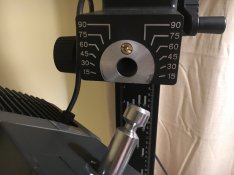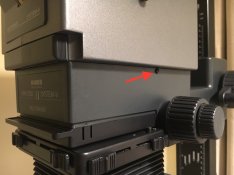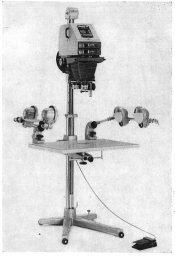Care to share how you do this? I've dabbled in this a little bit with Arista Lith 2.0 film but haven't really sunk my teeth into it yet.
I'm not sure quite how much help I can be. It's not that complicated if you already know how to make a print in the darkroom!
The reason for going this route is to make negatives for alt-process printing - in my case, cyanotypes and Namias' sepiaprints (there's (there was a url link here which no longer exists) started by NedL on the latter). The nice thing about it is that it offers me the opportunity to make contact prints of any size without having to have a camera of the appropriate format. It also means I can make large alt prints from any of the hundreds of rolls of 135 and 120 I've shot over the past few years since coming back to film.
I'd considered using reversal processing for all my rolls, but that means if I do want to make a conventional darkroom print, I have to faff about making a contact negative. This way is more flexible.
In the past I have tried making enlarged interpositives on paper then contacting those to make paper negatives. I got some decent results but there were some buts.
Then I read a thread at LFPF in which Bob Carnie talked about making interpos contacts from negatives and enlarging those - see
this thread . He suggested that there was an advantage to doing it this way in terms of preserving sharpness (if that's important to you).
Bob's approach seems to be to make a flat (low contrast) but very fully exposed interpos - lots of detail in the shadows - and control contrast in the enlargement and development stage. I'm not sure that this works for me, but then I'm at a fantastically lower skill- and experience level than Bob! I also think he is using continuous-tone ortho film (e.g. Ilford Ortho) rather than lith film.
FWIW, this is how I proceed ...
I picked up quite a large supply of old Agfa lith film by lucky chance on eBay recently - 40x50cm in boxes of 150 sheets

I'd experimented in the past shooting Arista lith film in LF cameras, and found my way to "tame" it was to grossly overexpose it and then grossly underdevelop it. SO I reckoned that a similar approach should work for this process.
So ... I start with pretty much any old negative, whether 135 or 120, within reason. By which I mean, I've picked reasonably "good" negatives that print easily - Goldilocks negatives, if you like. Not too thin, not too thick, not too contrasty.
I contact them to lith film under the enlarger.
On the baseboard of my enlarger I have a sheet of thick glass hinged by duct tape to a sheet of fibreboard. So, under the glass goes the lith and the negative I want to contact, emulsion to emulsion of course.
I keep the same head height on the enlarger for all my contact work, and defocus it.
Then I make a series of separate exposures of the frame I want on a strip of lith film - I usually start at f/8, and make 4, 8, 12 and 16 second exposures. Yes, I know the f/stop brigade will be hopping from foot to foot in frustration at my method, but they'll just have to suck it up

(Digression.
It's worth considering how you do the latter bit. It isn't quite the same as making test strips - you're exposing afresh each time, so I've ended up making a long thin mask out of black card to allow me to keep the lith strip static and move the negative along for each exposure; I didn't even bother trying to make contacts on fiddly little scraps the same size as the negative - doing it the way I have means I can cut it to a strip that fits my normal negative carriers for the final stage, so I can easily try differently exposed interpozzes to make the enlarged negatives.)
For my light source and head height, 10-15secs is usually in the ballpark at f/8.
Then I prewash the exposed film, for about 90 secs. I do this partly from habit, partly because it seems to mitigate any uneven development, which I have seen before in this sort of scenario.
Then, obviously, into the developer. I have experimented a bit with devs, and haven't quite settled on my preferred solution (pun unintentional).
The two I've used most are:
1. Very dilute D23 - very dilute indeed, in fact, at 1:13 or 1:14.
2. Soemarko's LC1B low-contrast developer at 1:3 or 1:5. You can find the formula for this stuff by searching APUG. n.b. this really is a low-contrast developer - at the suggested 1:5 - 1:10 dilutions Soemarko suggests.
I develop for about 8 mins in trays. Because it's ortho film, of course, we can observe progress under safelight, but it does take a bit of practice to know when you've got the right degree of development, and it's very easy to pull it too soon.
(I find that a flat interpos doesn't work for me. Ones that look about the same contrast as the original negative seem to be best. But, to emphasise, I'm still a real novice at this. I do own a densitometer but I never make measurements. I do it all by eye.)
Next ... hang the little buggers up to dry after a proper fix and wash. Wash and tidy everything, put away, Make tea. Eat supper. watch tv. get annoyed at the state of the world. block deplorables on twitter.
Now, onto making the final negative. Nothing rocketsciency here either.
Put interpos into enlarger, adjust height to make desired size of negative, focus. Make test strips as you would with an ordinary enlargement.
I use the same developers, dilutions and times as noted above.
Stop, fix, wash, hang etc.
Developer capacity is surprisingly high even for the D23 at 1:14. I can get quite a few whole-plate size negs out of a litre. It does exhaust though, and you do have to be on the ball about extending development time. But again of course one can develop by inspection so you shouldn't end up too far awry.
I have tried Rodinal in the past, and I'll try again one day, probably when my LC1B runs out. 1:100 or 1:150 will probably work.
My lith film is 20 to 30 years old, and it has a bit of age-fog. I have to dump 5ml/litre of 0.1% Benzotriazole solution into my developers to get rid of that (despite my being told in another thread that I'm completely wrong about the dilution and amount I'm using. Odd, because I haven't seen my interlocuter from that thread in my house looking at my solution, but there we are). Fresh film of course won't need this treatment.
When developing in trays I pay no attention to temperature (there, that'll annoy some of the technical obsessives). So long as the darkroom is comfortable to work in wearing a T-shirt, I reckon the developer's about the right temperature for me
Dust and hair are utter demons in this process. The tiniest dustbunny on your interpos (which you can't inspect by loupe until it's dry of course) can render it utterly useless. UT.TER.LY.
Now, for any naysayers or critics who want to jump in and tell me "you're doing it wrong" or some bollocks about not respecting the integrity of the metol blah blah ... no, I'm not doing it wrong. I'm doing it the way I've worked out how to do it. It may not be optimal. There may be better ways, better developers, better whatevers. I'm not staking a claim for this as being the best or only way of doing it. I was asked to describe what I do, so I have.
I hope it's interesting and helpful to you adelorenzo anyway.

















